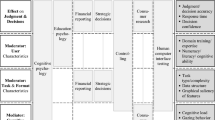Abstract
This paper raises the question of the prominence and use of statistical graphs in science, and argues that their use in problem solving analysis can best be understood in an ‘interactionist’ frame of analysis, including bio-emotion, culture, social organization, and environment as elements. The frame contrasts both with philosophical realism and with social constructivism, which posit two variables and one way causal flows. We next posit basic differences between visual, verbal, and numerical media of perception and communication. Graphs are thus seen as key interactive sites where different media are transformed into more interpretable forms. Examples are taken from Limnology where numbers are transformed into graphs to find patterns in them, and thus, by implication in the environmental materials from which the numerical measurements were taken. Their revisualization by passes a human cognitive limitation, for the direct analysis — interpretation of lists and tables of numbers, visual imaging being a cognitive strength. Sense of problem, conceptual repertoire, and social relations are seen to direct this pattern search and interpretive process.
Similar content being viewed by others
References
Amann, K., and K. Knorr-Cetina: 1988, ‘The Fixation of (Visual) Evidence’, Representation in Scientific Practice, Special issue ofHuman Studies 11 (2-3), 133–169.
Bazerman, C.: 1988,Shaping Written Knowledge: The Genre and Activity of the Experimental Article in Science, University of Wisconsin Press, Madison, Wisconsin.
Borell, M.: 1976, ‘The Instrumentation and the Rise of Modern Physiology’,Science and Technology Studies 5 (2), 53–62.
Burke, J.: 1985,The Day the University Changed, Little, Brown, and Company, Boston, pp. 134–157.
Cleveland, W.: 1984, ‘Graphs in Scientific Publications’,The American Statistician 38 (4), 261–269.
Cleveland, W., and R. McGill: 1983, ‘Graphical Perception: Theory, Experimentation, Application to the Development of Graphical Methods’,Journal of American Statistical Association 79, 531–554.
Cushing, D.: 1975,Marine Ecology and Fisheries, Cambridge University Press, Cambridge, UK.
Demey, M.: 1982,The Cognitive Paradigm, Reidel, Boston.
Dillon, P.: 1974, ‘The Phosphorus-Chlorophyll Relationship in Lakes’,Limnology Oceanography 19, 767–773.
Ferguson, E.: 1977, ‘The Minds' Eye: Nonverbal Thought in Technology’,Science 197, 827–836.
Fisher, H.: 1982,Mapping Information, Abt Books, Cambridge, Mass.
Freedman, R., R. Pisani, and R. Purves: 1978,Statistics, Norton, New York.
Funkhauser, H.: 1937, ‘The Graphical Presentation of Statistical Data’,Osiris III, 269–404.
Giere, R.: 1988,Explaining Science: A Cognitive Approach, University of Chicago Press, Chicago.
Gould, S.J.: 1989,Wonderful Life: The Burgess Shale and the Nature of History, W. W. Norton, New York.
Hoaglin, F., F. Moesteller, and J. Tukey: 1983,Understanding Robust and Exploratory Data, Wiley and Sons, New York.
Knorr-Cetina, K.: 1981,The Manufacture of Knowledge: An Essay on the Constructivist and Contextual Nature of Science, Pergamon Press, New York.
Knorr-Cetina, K.: 1989, ‘Ron Giere Explaining Science: The Cognitive Approach’, paper presented at the annual meeting of The Society for Social Studies of Science (4), Irvine, Calif. 11, 15–18, 1988.
Krohn, R.: 1990, ‘Are All Scientific Visuals the Same?’, 4-5 Meetings, Minneapolis, 10, 1990.
Latour, B.: 1986, ‘Visualization and Cognition: Thinking with Eyes and Hands’,Knowledge and Society 6, 1–40.
Latour B. and S. Woolgar: 1979,Laboratory Life: The Social Construction of Scientific Facts, Sage Publications, Beverly Hills, Calif.
Lynch, M.: 1985,Art and Artifact in Laboratory Science, Routledge and Kegan Paul, Boston.
Lynch, M.: 1988, ‘The Externalized Retina: Selection and Mathematization in the Visual Documentation of Objects in the Life Sciences’,Human Studies 11, 201–234.
Moesteller, F.: 1977,Data Analysis and Regression Addison-Wesley, Don Mills, Ontario.
Rudwick, M.: 1976, ‘The Emergence of Visual Language for Geological Science, 1760–1840’,History of Science 14, 149–195.
Rudwick, M.: 1985,The Great Devonian Controversy, University of Chicago Press, Chicago.
Schmid, C., and S. Schmid: 1979,Handbook of Graphic Presentation, Wiley and Sons, New York.
Tufte, E.: 1984,The Visual Display of Quantitative Information, Graphics Press, Cheshire, Connecticut.
Tukey, W.: 1977,Exploratory Data Analysis, Addison-Wesley, Reading, Massachusetts.
Wetzel, R.: 1975,Limnology, Saunders College Publishing 325, Philadelphia.
Author information
Authors and Affiliations
Rights and permissions
About this article
Cite this article
Krohn, R. Why are graphs so central in science?. Biol Philos 6, 181–203 (1991). https://doi.org/10.1007/BF02426837
Issue Date:
DOI: https://doi.org/10.1007/BF02426837




